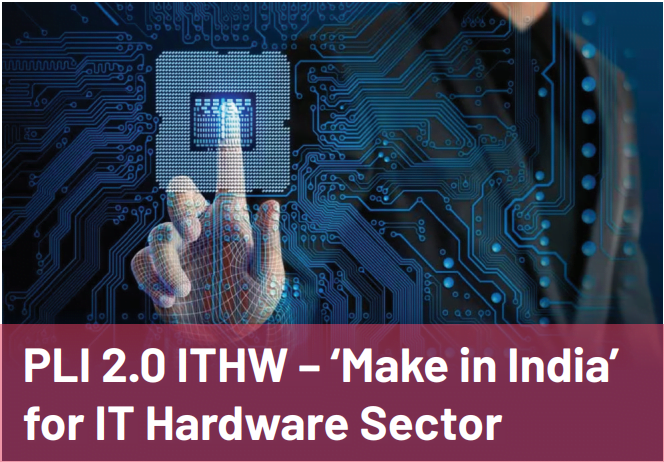Note: This article is published in FTCCI Review magazine dated 21 June 2023 which can be read at the below link (Refer Pg.no. 38 to 40) :
https://www.ftcci.in/source/ftapcci/FR%202023/FR%202023%2006%2021.pdf
The Government of India (“GoI”) through Ministry of Electronics and Information Technology (MEITY) has approved Production Linked Incentive Scheme 2.0 for IT Hardware (PLI 2.0 ITHW) on 17 May 2023 for USD 2.07 billion (INR 170 billion) to achieve broadening and deepening of the manufacturing ecosystem by encouraging the localisation of components and sub-assemblies and allowing for a longer duration to develop the supply chain within the country for which the notification is issued on 29 May 2023 and the application window is opened since 1 June 2023 for the next 45 days initially which may be extended.
The manufacturing units sanctioned under the programme would be eligible for getting PLI on annual basis on incremental sales of target segment product as Laptops, Tablets, All-in-one-PC, Servers, and Ultra Small Form Factor (USFF) for 6 years w.e.f. 1 July 2023 or may choose starting date of Financial Year (FY) 2023-24 or FY 2024-25 also. The total applicant to be selected will be as per budget availability on the basis of PLI quoted by the applicants for respective category (Global – 2, Hybrid – 5 and Domestic -9).
The various aspects of PLI 2.0 ITHW has been further decoded as mentioned below:
- Key aspects
- Eligibility criteria and incentives rates
- Penalty for non-compliance
1. Key aspects
The key aspects of the PLI 2.0 ITHW are:
- The Scheme will be applicable for 6 years from that date. Incentives shall be applicable from 1 July 2023 or 1 April 2024 or 1 April 2025 for 6 years depending upon the applicant’s choice.
- Base year FY 2022-23/FY 2023-24/FY 2024-25 will be considered for computation of incremental sales as per applicability. However, for the purpose of qualification criteria, FY 2021-22 shall be considered irrespective of year of participation.
- Cap on maximum incentive: INR 4,500 Cr. for Global Companies, INR 2,250 Cr. for Hybrid (Global/Domestic) companies and INR 500 Cr. for Domestic companies
- PLI 1.0 applicants will be allowed to apply under PLI 2.0.
- Applicants of Existing PLI can continue in existing PLI
- Old Applicants – Migrate to PLI 2.0 – Start from 2nd year in PLI 2.0, Investment will be counted
- Old Applicant – Can participate as new applicant for 6 years, with new Investment
- PLI 1.0 conditions will remain same for sales thresholds for Global/Domestic category for first 4 years.
- The beneficiary of PLI 2.0 ITHW shall use firmware for servers from Indian sources or other trusted foreign sources as certified by MEITY.
2. Eligibility criteria and incentive rates:
The support under the PLI 2.0 ITHW Scheme shall be provided to global and domestic companies fulfilling the eligibility criteria laid down in the scheme guidelines for manufacturing of goods in India. The Domestic Companies shall be defined as those which are owned by resident Indian citizens as defined in the FDI Policy Circular of 2020.
The PLI 2.0 ITHW shall extend an average incentive of around 5% for localization of items given in the Annexure-B of the notification. The applicant will localize PCBA and Assembly during the first year and thereon at least one component/sub-assembly need to be added every year from the bouquet of optional components/ sub-assemblies provided. Most of the target segments under PLI IT Hardware are also made from semiconductors hence components/sub-assemblies such as SSD, Memory module, display panel are also part of localization and higher incentive has been provided to incentivize manufacturing of Semiconductors in India. Incentive offered for localization shall taper down every year as per the trajectory in Annexure-B of the notification. The selection and ranking would be based on Global Revenue of ESDM / Target Segment Revenue for FY 2022-23 and the final ranking (combining all) will be done on the basis of higher ESDM revenue followed by Target segment revenue subject to availability of fund as mentioned below:
| Category | Consolidated Global Manufacturing Revenue (including its Group Companies) | ESDM revenue – Electronics hardware products / sub-assemblies / components |
| Global | > INR 5,000 crore for the target segment | > INR 10,000 crore |
| Domestic | > INR 10 crore for the target segment | > INR 20 crore |
The investment thresholds and incremental sales would be:
| Category | Incremental Investment after 31 March 2023 | Incremental Sales of Manufactured Goods over Base Year |
| Global IT Hardware Companies (i) Laptops (Invoice value of INR 30,000 and above), (ii) Tablets (Invoice value of INR 15,000 and above), (iii) All-in-One PCs (iv) Servers (v) Ultra Small Form Factor (USFF) | INR 500 Crore over 6 Years; Cumulative Minimum (Crore): Year 1: INR 50 Crore Year 2: INR 150 Crore Year 3: INR 250 Crore Year 4: INR 350 Crore Year 5: INR 450 Crore Year 6: INR 500 Crore | Year 1: INR 1,000 Crore Year 2: INR 2,500 Crore Year 3: INR 5,000 Crore Year 4: INR 10,000 Crore Year 5: INR 12,000 Crore Year 6: INR 15,000 Crore |
| Hybrid (Global/Domestic)companies (i) Laptops (Invoice value of INR 30,000 and above) (ii) Tablets (Invoice value of INR 15,000 and above) (iii) All-in-One PCs (iv) Servers (v) Ultra Small Form Factor (USFF) | INR 250 Crore over 6 Years; Cumulative Minimum (Crore): Year 1: INR 25 Crore Year 2: INR 75 Crore Year 3: INR 125 Crore Year 4: INR 175 Crore Year 5: INR 225 Crore Year 6: INR 250 Crore | Year 1: INR 500 Crore Year 2: INR 1,250 Crore Year 3: INR 2,500 Crore Year 4: INR 5,000 Crore Year 5: INR 6,000 Crore Year 6: INR 7,500 Crore |
| Domestic Companies (i) Laptops (ii) Tablets (iii) All-in-One PCs (iv) Servers (v) Ultra Small Form Factor(USFF) | INR 20 Crore over 6 Years; Cumulative Minimum (Crore): Year 1: INR 4 Crore Year 2: INR 8 Crore Year 3: INR 12 Crore Year 4: INR 15 Crore Year 5: INR 18 Crore Year 6: INR 20 Crore | Year 1: INR 50 Crore Year 2: INR 100 Crore Year 3: INR 200 Crore Year 4: INR 300 Crore Year 5: INR 400 Crore Year 6: INR 500 Crore |
Based on industry suggestion, the investment made in contract manufacturing facilities shall also be counted as the investment of the applicant and further allowed to count incremental investment done by manufacturers of components/sub-assemblies etc. for meeting the incremental investment thresholds for individual year, provided it is established that such manufacturer is exclusively manufacturing components/sub-assemblies for the applicants.
3. Penalty for non-compliance
Under PLI 2.0 ITHW, following penal implications are provided:
For shortfall of investment in a particular year: In case there is a shortfall in investment by X% for a particular year, an applicant will get X/2 % less PLI, provided shortfall (X%) is not more than 40%. However, if an applicant is able to achieve cumulative investment target in subsequent year(s) then held back PLI amount will be released without interest.
Gap in actual and projected PLI estimates: To keep projection discipline in the scheme, there will be a provision for penalty of 5% from payable PLI amount if actual PLI amount for a year is less by 25%-50% and penalty of 10% if shortfall is more than 50% from the estimated PLI amount given by the applicant at the time of application.
Over the years, the IT Hardware manufacturing capability and capacity in the country has progressively declined and many units have either ceased operations or are operating at low capacities. The unutilized installed manufacturing capacity is a low hanging fruit as regards to quickly scaling up manufacturing in the country. The PLI 2.0 ITHW proposes a financial incentive to boost domestic manufacturing and attract large investments in the value chain.
About the Author:

Vineet has over 17+ years of consulting experience in leadership role in Tax and Regulatory Stream [Indirect tax including GST (around 13 years in Big 4)] and working with leading players in diverse industry sectors including renewable sector. He has delivered successfully as part of Darda Advisors LLP on various approvals and disbursements under Central and State Policies including ongoing MEITY and other Ministries’ PLI Schemes. Vineet has conducted various sessions (Seminars and webinars) on various tax and regulatory topics (including GST), Central and State schemes at Client’s place, Business Parks, and other forums (ASCI, FTCCI, JICA, KOTRA, EPC, ICAI, ICFAI, JITO, RGA and others).
https://www.linkedin.com/in/d-vineet-suman-a5a28729
You can reach out on 91-99529 26239 or email [email protected].
Follow Darda Advisors LLP: https://www.linkedin.com/company/darda-advisors-llp


